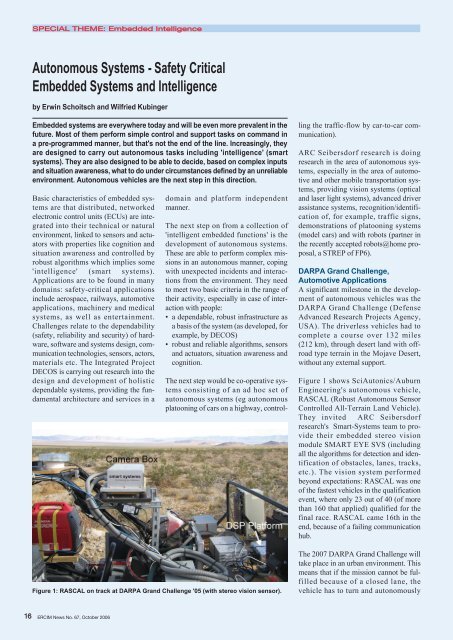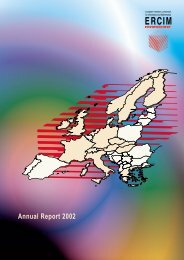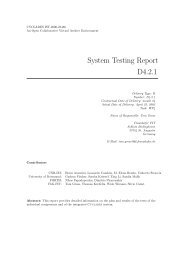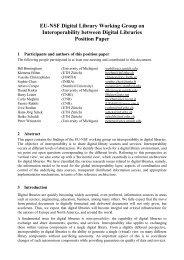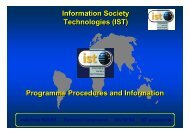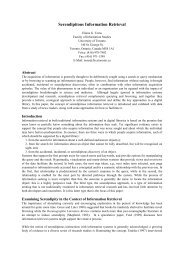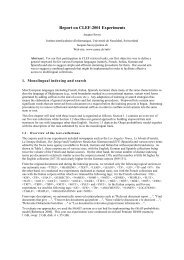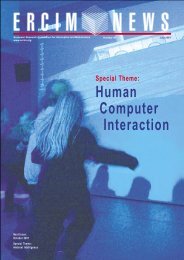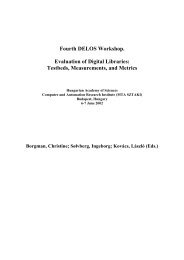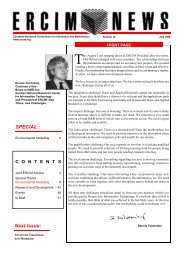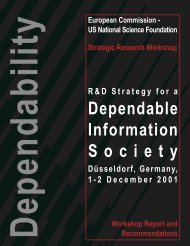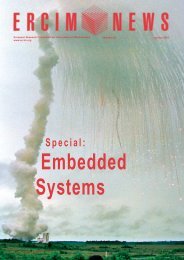Towards a Platform for Widespread Embedded Intelligence - ERCIM
Towards a Platform for Widespread Embedded Intelligence - ERCIM
Towards a Platform for Widespread Embedded Intelligence - ERCIM
Create successful ePaper yourself
Turn your PDF publications into a flip-book with our unique Google optimized e-Paper software.
SPECIAL THEME: <strong>Embedded</strong> <strong>Intelligence</strong><br />
Autonomous Systems - Safety Critical<br />
<strong>Embedded</strong> Systems and <strong>Intelligence</strong><br />
by Erwin Schoitsch and Wilfried Kubinger<br />
<strong>Embedded</strong> systems are everywhere today and will be even more prevalent in the<br />
future. Most of them per<strong>for</strong>m simple control and support tasks on command in<br />
a pre-programmed manner, but that's not the end of the line. Increasingly, they<br />
are designed to carry out autonomous tasks including 'intelligence' (smart<br />
systems). They are also designed to be able to decide, based on complex inputs<br />
and situation awareness, what to do under circumstances defined by an unreliable<br />
environment. Autonomous vehicles are the next step in this direction.<br />
Basic characteristics of embedded systems<br />
are that distributed, networked<br />
electronic control units (ECUs) are integrated<br />
into their technical or natural<br />
environment, linked to sensors and actuators<br />
with properties like cognition and<br />
situation awareness and controlled by<br />
robust algorithms which implies some<br />
'intelligence' (smart systems).<br />
Applications are to be found in many<br />
domains: safety-critical applications<br />
include aerospace, railways, automotive<br />
applications, machinery and medical<br />
systems, as well as entertainment.<br />
Challenges relate to the dependability<br />
(safety, reliability and security) of hardware,<br />
software and systems design, communication<br />
technologies, sensors, actors,<br />
materials etc. The Integrated Project<br />
DECOS is carrying out research into the<br />
design and development of holistic<br />
dependable systems, providing the fundamental<br />
architecture and services in a<br />
16 <strong>ERCIM</strong> News No. 67, October 2006<br />
domain and plat<strong>for</strong>m independent<br />
manner.<br />
The next step on from a collection of<br />
'intelligent embedded functions' is the<br />
development of autonomous systems.<br />
These are able to per<strong>for</strong>m complex missions<br />
in an autonomous manner, coping<br />
with unexpected incidents and interactions<br />
from the environment. They need<br />
to meet two basic criteria in the range of<br />
their activity, especially in case of interaction<br />
with people:<br />
• a dependable, robust infrastructure as<br />
a basis of the system (as developed, <strong>for</strong><br />
example, by DECOS)<br />
• robust and reliable algorithms, sensors<br />
and actuators, situation awareness and<br />
cognition.<br />
The next step would be co-operative systems<br />
consisting of an ad hoc set of<br />
autonomous systems (eg autonomous<br />
platooning of cars on a highway, control-<br />
Figure 1: RASCAL on track at DARPA Grand Challenge '05 (with stereo vision sensor).<br />
ling the traffic-flow by car-to-car communication).<br />
ARC Seibersdorf research is doing<br />
research in the area of autonomous systems,<br />
especially in the area of automotive<br />
and other mobile transportation systems,<br />
providing vision systems (optical<br />
and laser light systems), advanced driver<br />
assistance systems, recognition/identification<br />
of, <strong>for</strong> example, traffic signs,<br />
demonstrations of platooning systems<br />
(model cars) and with robots (partner in<br />
the recently accepted robots@home proposal,<br />
a STREP of FP6).<br />
DARPA Grand Challenge,<br />
Automotive Applications<br />
A significant milestone in the development<br />
of autonomous vehicles was the<br />
DARPA Grand Challenge (Defense<br />
Advanced Research Projects Agency,<br />
USA). The driverless vehicles had to<br />
complete a course over 132 miles<br />
(212 km), through desert land with offroad<br />
type terrain in the Mojave Desert,<br />
without any external support.<br />
Figure 1 shows SciAutonics/Auburn<br />
Engineering's autonomous vehicle,<br />
RASCAL (Robust Autonomous Sensor<br />
Controlled All-Terrain Land Vehicle).<br />
They invited ARC Seibersdorf<br />
research's Smart-Systems team to provide<br />
their embedded stereo vision<br />
module SMART EYE SVS (including<br />
all the algorithms <strong>for</strong> detection and identification<br />
of obstacles, lanes, tracks,<br />
etc.). The vision system per<strong>for</strong>med<br />
beyond expectations: RASCAL was one<br />
of the fastest vehicles in the qualification<br />
event, where only 23 out of 40 (of more<br />
than 160 that applied) qualified <strong>for</strong> the<br />
final race. RASCAL came 16th in the<br />
end, because of a failing communication<br />
hub.<br />
The 2007 DARPA Grand Challenge will<br />
take place in an urban environment. This<br />
means that if the mission cannot be fulfilled<br />
because of a closed lane, the<br />
vehicle has to turn and autonomously


